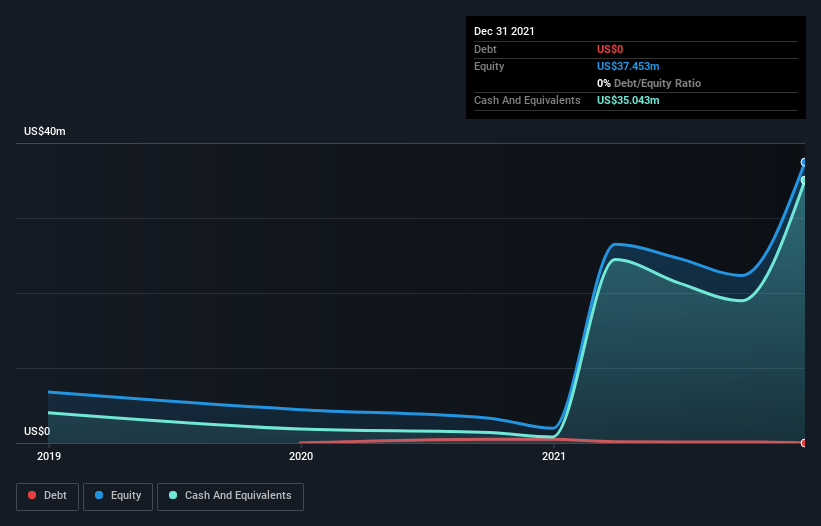- United States
- /
- Biotech
- /
- NasdaqCM:LGVN
Companies Like Longeveron (NASDAQ:LGVN) Are In A Position To Invest In Growth

Just because a business does not make any money, does not mean that the stock will go down. Indeed, Longeveron (NASDAQ:LGVN) stock is up 141% in the last year, providing strong gains for shareholders. But the harsh reality is that very many loss making companies burn through all their cash and go bankrupt.
So notwithstanding the buoyant share price, we think it's well worth asking whether Longeveron's cash burn is too risky. For the purposes of this article, cash burn is the annual rate at which an unprofitable company spends cash to fund its growth; its negative free cash flow. First, we'll determine its cash runway by comparing its cash burn with its cash reserves.
See our latest analysis for Longeveron
How Long Is Longeveron's Cash Runway?
A company's cash runway is the amount of time it would take to burn through its cash reserves at its current cash burn rate. When Longeveron last reported its balance sheet in December 2021, it had zero debt and cash worth US$35m. In the last year, its cash burn was US$11m. Therefore, from December 2021 it had 3.2 years of cash runway. A runway of this length affords the company the time and space it needs to develop the business. You can see how its cash balance has changed over time in the image below.

How Well Is Longeveron Growing?
One thing for shareholders to keep front in mind is that Longeveron increased its cash burn by 317% in the last twelve months. And that is all the more of a concern in light of the fact that operating revenue was actually down by 77% in the last year, as the company no doubt scrambles to change its fortunes. In light of the above-mentioned, we're pretty wary of the trajectory the company seems to be on. While the past is always worth studying, it is the future that matters most of all. So you might want to take a peek at how much the company is expected to grow in the next few years.
How Easily Can Longeveron Raise Cash?
Even though it seems like Longeveron is developing its business nicely, we still like to consider how easily it could raise more money to accelerate growth. Companies can raise capital through either debt or equity. Many companies end up issuing new shares to fund future growth. By looking at a company's cash burn relative to its market capitalisation, we gain insight on how much shareholders would be diluted if the company needed to raise enough cash to cover another year's cash burn.
Since it has a market capitalisation of US$326m, Longeveron's US$11m in cash burn equates to about 3.4% of its market value. Given that is a rather small percentage, it would probably be really easy for the company to fund another year's growth by issuing some new shares to investors, or even by taking out a loan.
How Risky Is Longeveron's Cash Burn Situation?
Even though its increasing cash burn makes us a little nervous, we are compelled to mention that we thought Longeveron's cash runway was relatively promising. While we're the kind of investors who are always a bit concerned about the risks involved with cash burning companies, the metrics we have discussed in this article leave us relatively comfortable about Longeveron's situation. On another note, Longeveron has 5 warning signs (and 1 which is a bit unpleasant) we think you should know about.
Of course Longeveron may not be the best stock to buy. So you may wish to see this free collection of companies boasting high return on equity, or this list of stocks that insiders are buying.
New: AI Stock Screener & Alerts
Our new AI Stock Screener scans the market every day to uncover opportunities.
• Dividend Powerhouses (3%+ Yield)
• Undervalued Small Caps with Insider Buying
• High growth Tech and AI Companies
Or build your own from over 50 metrics.
Have feedback on this article? Concerned about the content? Get in touch with us directly. Alternatively, email editorial-team (at) simplywallst.com.
This article by Simply Wall St is general in nature. We provide commentary based on historical data and analyst forecasts only using an unbiased methodology and our articles are not intended to be financial advice. It does not constitute a recommendation to buy or sell any stock, and does not take account of your objectives, or your financial situation. We aim to bring you long-term focused analysis driven by fundamental data. Note that our analysis may not factor in the latest price-sensitive company announcements or qualitative material. Simply Wall St has no position in any stocks mentioned.
About NasdaqCM:LGVN
Longeveron
A clinical stage biotechnology company, develops cellular therapies for aging-related and life-threatening conditions in the United States.
Moderate with adequate balance sheet.
Similar Companies
Market Insights
Community Narratives




